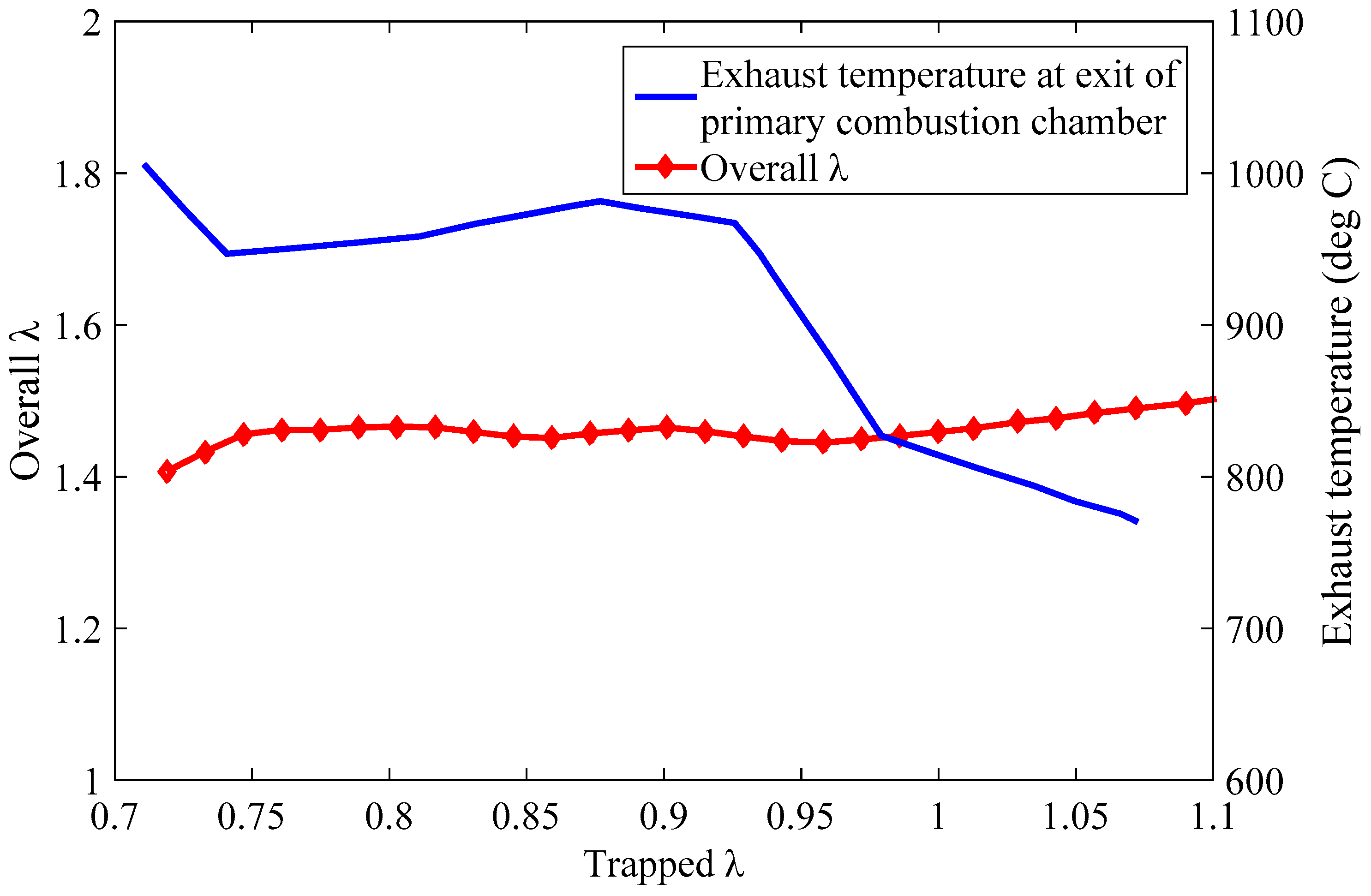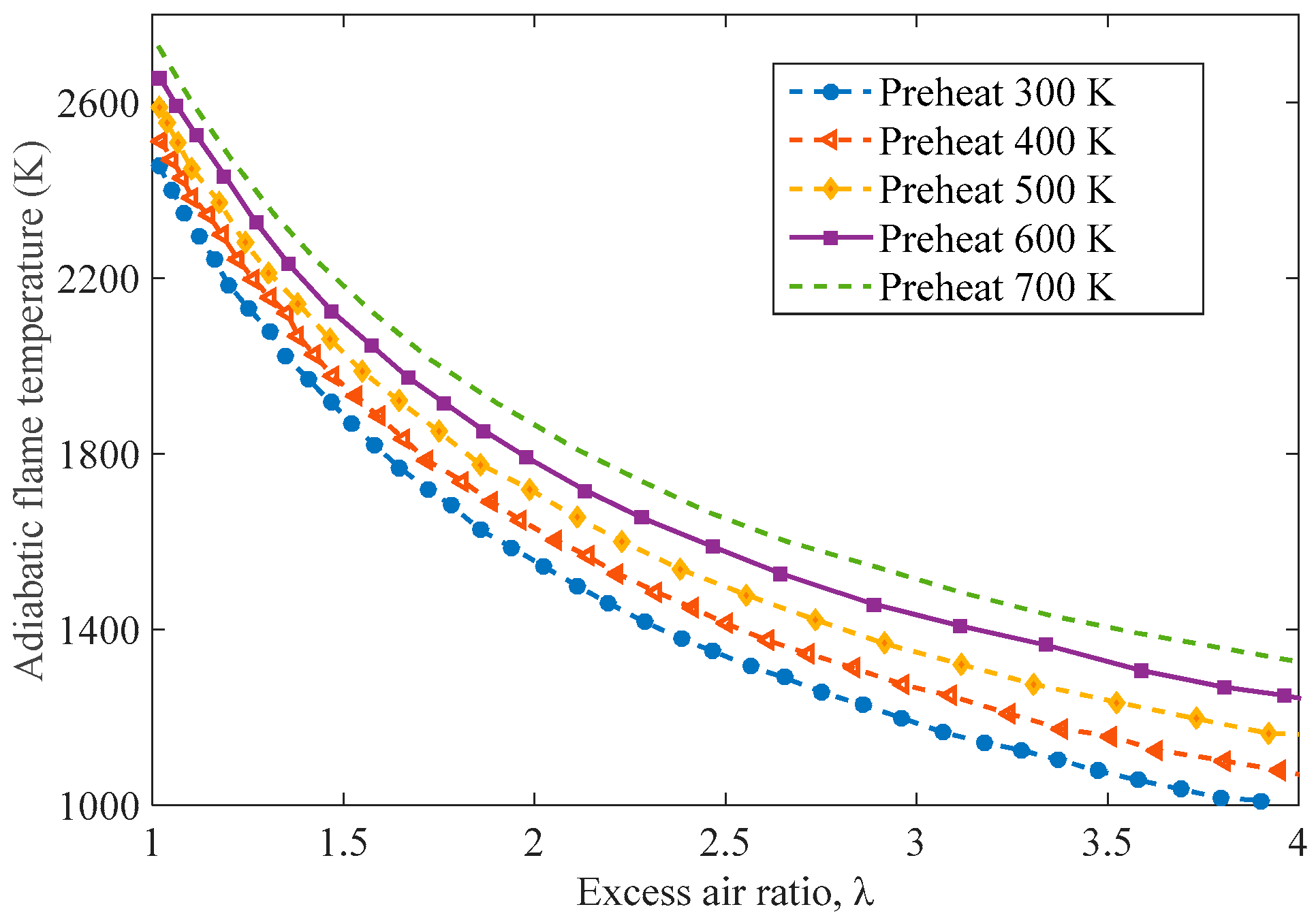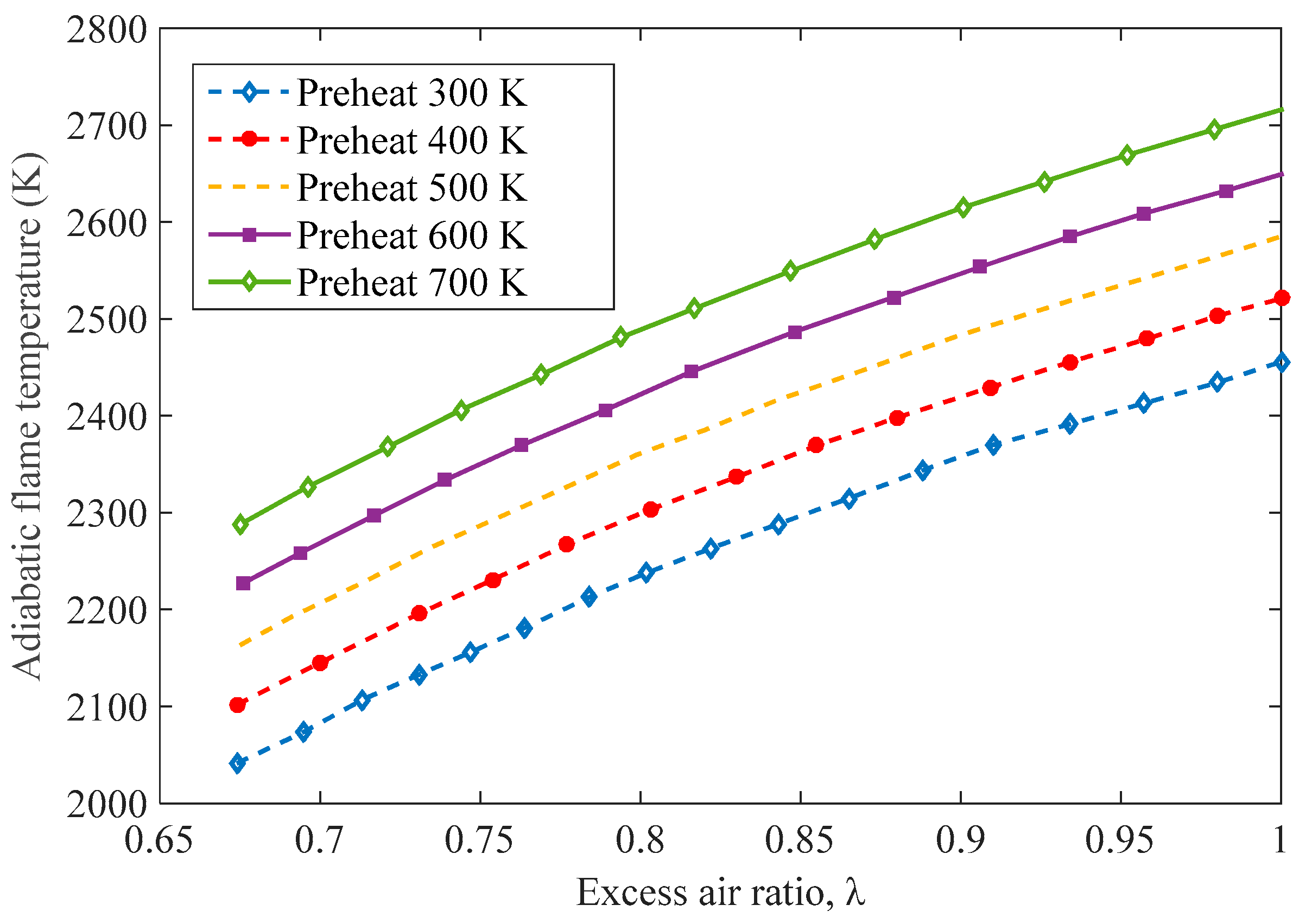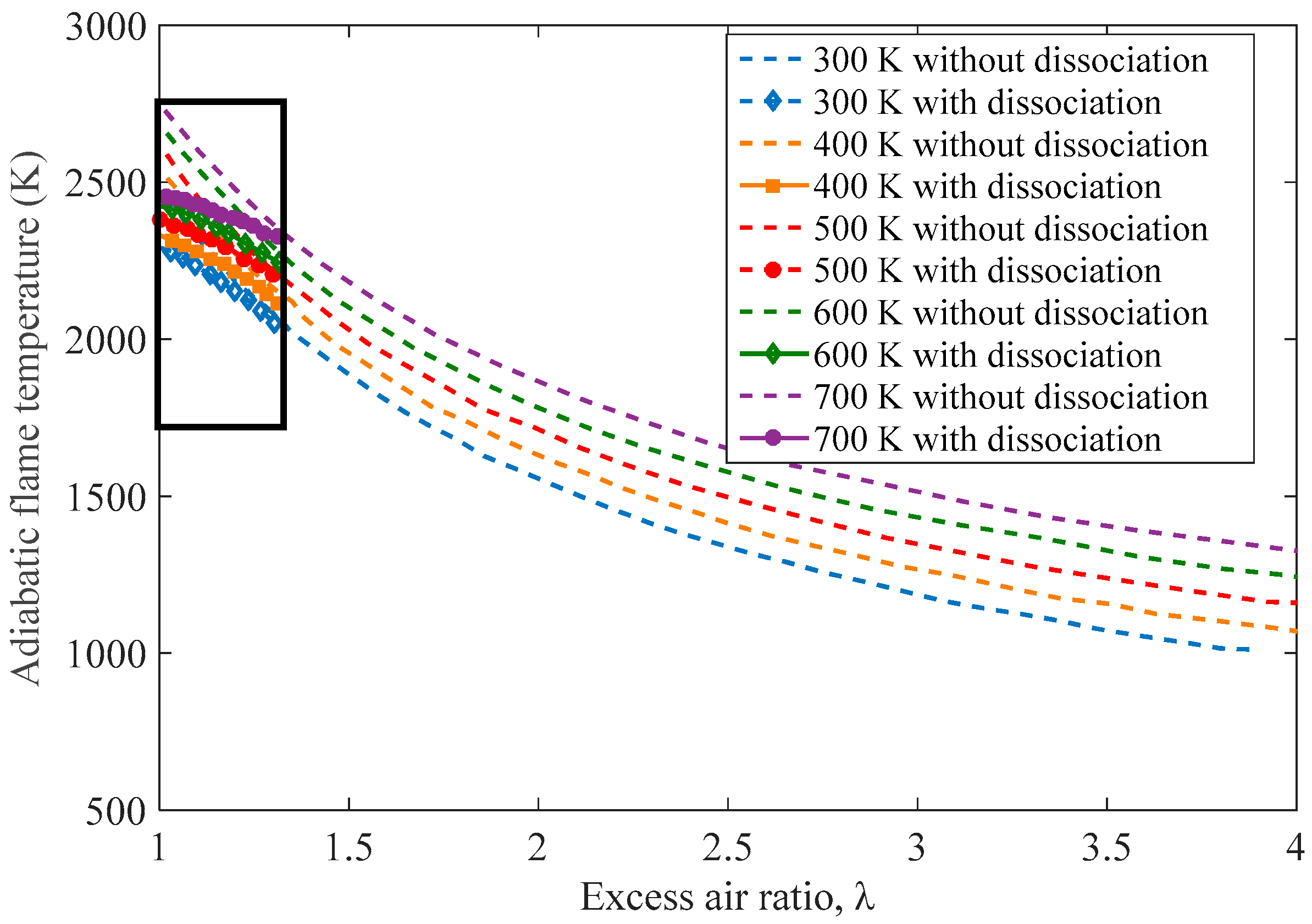1. Introduction
In the last couple of decades, the power output from slow speed diesel engines has increased steadily to meet the high propulsion power demand of large container vessels. This has motivated engine makers to increase the power density (output per cylinder) up to 5800 kW (Wärtsilä–Sulzer RTA96-C Common Rail marine compression-ignition engine) and reduce the specific weight from 55 to 30 kg/kW with the use of new materials and modern design tools [
1]. This has resulted in more power from the same bore size and number of cylinders for an engine family. Other key drivers for engine development are low specific fuel oil consumption, which influences the direct operating costs of a ship, and environmental legislation limiting the level of harmful pollutants from diesel engines [
2,
3,
4,
5,
6]. Rising fuel prices and enforcement of the legislation limiting the NO
x and SO
x from marine diesel engines have made these drivers more important [
7,
8,
9,
10]. A reduction in the fuel consumption can be achieved by running the cylinder hotter, operating closer to stoichiometric conditions where cycle temperatures are higher, and increasing the volume expansion ratio to extract more work for a fixed heat input. This is achieved during the engine optimisation with near uniform air to fuel ratio across the combustion chamber but at the expense of a smaller safety margin between normal operation and thermal overload for continuous service rating.
‘Thermal Overload’ can be defined as a condition under which design threshold values such as surface temperature of combustion chamber components is exceeded. The consequence is a reduction in operating life of the component or catastrophic failure depending on the extent of overload. Combustion chamber components such as the cylinder head, exhaust valve, cylinder liner and pistons are made of materials that meet the necessary design objectives such as good tribological properties for the cylinder liner and high hot corrosion resistance of exhaust valves on heavy fuel oil burning engines. A predictive trend establishing the deterioration of engine health due to normal wear and tear in components is acceptable provided corrective action is undertaken with preventive maintenance or condition monitoring to minimise loss of performance. If the necessary preventive maintenance or health monitoring of components taking part in the combustion or gas exchange process is not carried out, it could lead to a thermal overload condition.
The type of material used and the rate of heat removal are two of the many other factors that limit the operating temperature of a component. For a cylinder liner made of pearlitic grey cast iron with good tribological properties, the surface temperature should be limited to 370 °C to prevent ‘heat cracks’ from allotropic expansion of the material [
11]. Therefore, to increase engine power, the design constraint is taken care of in present day diesel engines with a deep cylinder cover, which means only a negligible proportion of the cylinder liner is exposed to the combustion process. The cylinder cover is made of cast steel which can withstand higher temperatures. The piston crown is made of forged chrome molybdenum steel without any form of cladding and can sustain relatively high surface temperatures but has very poor corrosion resistance to vanadate salts deposited on it as part of the combustion process. It is one of two combustion chamber components that is cooled intermittently, in addition to constant underside cooling, by cold scavenge air during the gas exchange process. If it is expected that the surface temperature will be above the design threshold due to high heal flux then a cladding with high corrosion resistance and low thermal conductivity needs to be applied. Another component that is subjected to the most arduous conditions is the exhaust valve spindle that is cooled intermittently by the scavenge air and its contact with the valve seat. It is made of Nimonic, which offers greater resistance against hot corrosion.
To date, there has been research into the solutions to the thermal overload in the cylinder head of a heavy duty 6-cylinder diesel engine, in which thermal cracks were found in the valve-bridge [
12]. The temperature of the cylinder head bottom was measured, the flow distribution of coolant through the upper nozzles of the cylinder head bottom was tested, and the water jacket of the cylinder head was inquired. A 3D model was developed to simulate the water jacket performance in the worst cooling conditions. Four designs of water jacket were proposed and simulated, and all these schemes showed improvement in the flow field of the water jacket. From the test results, the maximum temperature in the value bridge of the cylinder head was reduced by 9.2 °C, and the temperature gradient reduction was 19.55%, indicating that the proposed designs reduced the thermal stress of the diesel engine cylinder head [
12].
Engine pistons were regarded as an important part of an engine, and new geometries, materials, and manufacturing techniques are always being proposed for pistons [
13]. Notwithstanding these studies, a huge number of damaged pistons were reported, among which thermal fatigue and mechanical fatigue played an important role and was analysed by Silva. Stresses at the piston crown and pin holes, as well as stresses at the grooves and skirt as a function of land clearances were presented. Thermal fatigue cracks were easy to identify as some visible fatigue cracks on the areas with cyclic thermal gradients could be seen on brake disks and other components. Two reasons were considered through which thermal gradients act on stressed, i.e., vertical distribution of the temperature along the piston, and temperature difference at the head of the piston due to the flow of the hot air or fuel impingement [
13].
An experimental and analytical approach was undertaken by Lee et al. to study stress distributions and causes of failure in diesel cylinder heads [
14]. The influence of thermal shock loading under rapid transients was analysed, and the steady state temperature gradients and the level of temperatures were reported as the primary causes of thermal fatigue in cast-iron cylinder heads [
14]. They also provided a finite element analysis to predict the detailed temperature and stress distributions within the cylinder head, and validated the model using measurements. These works attributed thermal shock loading as playing a role in thermal fatigue, along with steady-state temperature gradients and the level of temperatures [
14].
In order to protect the structural engineering materials of engines from corrosion, erosion, and wear, thermal barrier coating technologies have been proposed and investigated [
15,
16,
17,
18,
19]. Different types of coating were used to provide engine lubrication and thermal insulation, as they could insulate engine components from the hot gas stream, which improved the engine durability [
16,
17]. However, very little evidence has been published that considers the probable causes of the thermal overload that will cause thermal fatigue from the engine side. None of them addressed the suggestions of diesel engine operation conditions in order to avoid the engine thermal overload.
In this paper, the hypothesis for the most probable causes of thermal overload of diesel engines is discussed and validated. Low λ value is identified as the most probable cause of voluminous flame production, resulting in a high surface temperature of engine components, i.e., engine thermal overload. After the probable cause of the engine thermal overload is identified, a numerical calculation will be presented to estimate the flame temperature for various air excess ratio, which will provide guidance for the operation conditions of diesel engines to avoid engine thermal fatigue due to thermal overload.
4. Estimation of Flame Temperature with Different λ Values
In the previous section, it has been identified that a voluminous flame in the vicinity of combustion chamber components will result in high thermal stress as a function of the flame temperature. Meanwhile, voluminous flame production at low oxygen concentration. It is necessary to estimate the flame temperature for various λ values to identify the scale of the problem.
Calculations were made for a steady flow constant pressure combustion chamber operating on gas oil to estimate the adiabatic flame temperature and residual oxygen volume in the exhaust gas products. The fuel combustion is assumed to be complete, and the products will be CO
2, H
2O and N
2. The classic combustion equation, where
is the excess air coefficient is given by:
An elemental balance of the reactants and products returns the following molar volumes of the products of combustion, i.e., b = 12, c = 13, d = 18.5 × (a − 1).
From classical thermodynamics and the first law of a differential form of the general energy equation for a control volume (CV) can be obtained in molar terms:
where
is the total CV system energy;
is the rate of heat transfer to/from the CV;
is rate of work transfer to/from the CV;
is the molar flow rate of material into the CV;
is the molar flow rate of material out of the CV;
is the intensive total energy per unit mole of material into the CV; and
is the intensive total energy per unit mole of material out of the CV.
If all the properties within the CV, as well as those transferred across the CV boundary, do not change with time (steady state and steady flow), then the rate of change of energy must remain constant. Therefore,
and
Considering the adiabatic combustion (at constant pressure), the enthalpy of reactants will be equal to the enthalpy of products which results in an increase of temperature of products:
The intensive total energy
into the CV is the sum of potential, kinetic, internal and chemical potential energy. In the combustion process, the kinetic and potential energy will be negligible compared to the internal and chemical potential energy; therefore, the total energy
, into the CV system can be written as:
where
is the heat of formation and
is the enthalpy at
T (in kelvin).
As the general energy equation equates the heat and work transfer rates to changes in energy levels of materials that undergo state changes, it is the difference between the energy terms that is of interest. Returning to the assumption that combustion takes place at constant pressure, an enthalpy balance of the products and reactants can be used to calculate the temperature of the flame in the cylinder for different values of λ. Therefore, equation above becomes:
where
is the thermodynamic reference temperature of 298 K.
Re-writing the above equation in terms of the products gives:
Re-writing the above equation in terms of the reactants gives:
where
is the temperature of the fuel;
is the temperature at the start of constant pressure combustion process; and
is the temperature at the end of constant pressure combustion process.
The use of enthalpy balance to calculate the flame temperature at fixed λ can be best understood with the following example in which combustion is assumed to take place under stoichiometric conditions, i.e.,
a = 1, and inlet air temperature is 400 K with a corresponding pressure of 1.46 bar. The general combustion equation can be rewritten as:
Using the enthalpy balance equation and the JANAF (Joint Army-Navy-Air Force) thermo-chemical tables, gives:
The above two equations gives:
The temperature of products from the equation above can be obtained by iteration is equal to 2530 K. Calculation code was written in Matlab software (The MathWorks, Inc., Natick, MA, USA) and used to derive temperatures for a range of λ values at different amount of air preheat.
The data in
Figure 4 shows the calculation results (using the energy balance equation, where the enthalpy of products is always equal to the enthalpy of reactants) starting from stoichiometric condition. This is a more complex method of obtaining the flame temperature compared to the simpler heat release approach. However, the advantage of this method is that it will provide a more accurate temperature estimate because the variation in gas properties due to temperature and composition changes that are taken into account. This theoretical analysis does not include dissociation effects, which will result in a reduction in flame temperatures when λ values approach unity.
The results in
Figure 5 demonstrate the relationship between flame temperature and λ values, indicating a rapid increase in flame temperature as stoichiometric combustion is approached. The flame temperature is greatest at stoichiometric condition and reduced with increase in λ. For fuel rich conditions, the data in
Figure 5 shows the theoretical adiabatic flame temperature without dissociation for different λ values.
Calculations made so far were based on complete combustion of hydrocarbon fuel in air with the resulting in CO
2, H
2O, N
2 and O
2 products. This method for flame temperature calculation is accurate for temperatures below 1500 K as dissociation, and breakdown of products backing their original elements does not take place. The effect of dissociation results in a reduction of the flame temperature and this becomes significant when temperatures are in excess of 2000 K. In the dissociation mechanism, some of the CO
2 will split back into CO and O
2, and H
2O into H
2 and O
2. The results show that there is always some oxidant left in the products. Dissociation is an endothermic process and will reduce the amount of energy released. The effect of dissociation on the peak flame temperature is more pronounced when operating close to stoichiometric conditions, which is shown in
Figure 6, with no dissociation being compared in the same figure.
5. Discussion
For most diesel engines, other than the homogeneous charge compression ignition engines, the air to fuel ratio is stratified across the combustion space. This results in non-uniform temperatures across the piston crown in the radial and circumferential direction In theory, as discussed above, maximum flame temperature is observed at λ = 1. However, in practice, due to non-uniformity in the air-fuel mixtures, this occurs at λ 1.2 (for continuous combustion systems). For diesel engines, with intermittent combustion, the value of λ at which maximum flame temperature is observed could be higher, possibly in the region of λ = 1.6 to λ = 1.8. An engine operating with λ = 1.6 will have its combustion chamber components running significantly hotter than those operating at greater values of λ. This indicates that engine components responsible for maintaining the pre-requisite air to fuel ratio within the combustion space are critical since malfunction will result in thermal overloading of combustion chamber components.
It could be argued that, in fuel rich conditions, the maximum adiabatic flame temperature is less than stoichiometric conditions; therefore, combustion chamber components should not fail due to temperatures exceeding design threshold values. However, there are significant problems with combustion chamber components failing through excessive temperatures in fuel rich conditions. This does not occur under lean burn conditions, where the flame is more compact and a boundary of air exists between the flame and the component surface. This voluminous flame comes into contact with the combustion chamber components, increasing the rate of heat input, and also inducing the engine to thermal overload.












